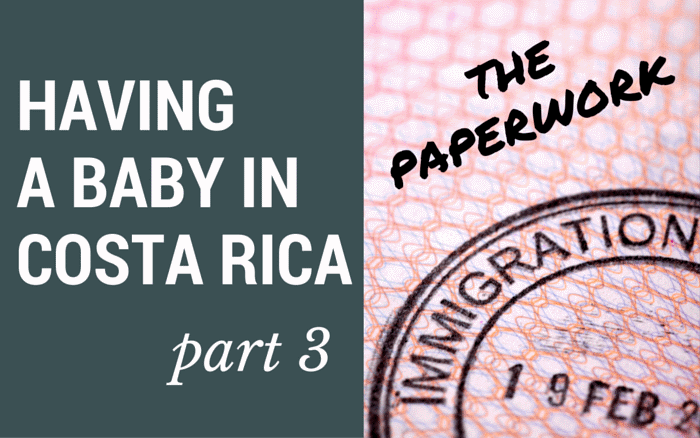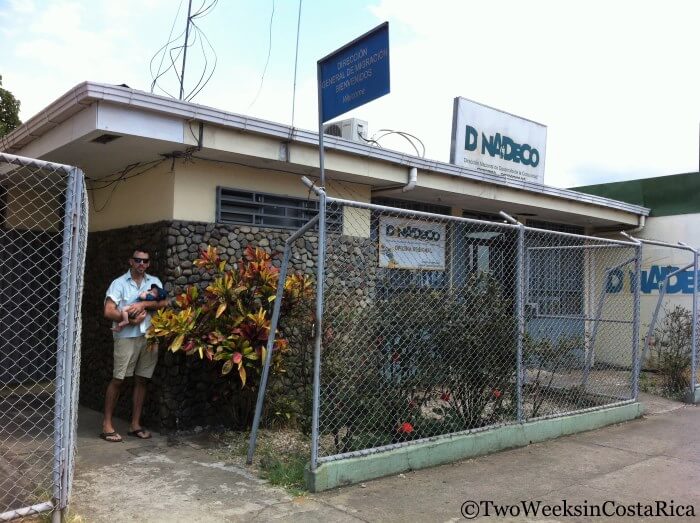Last Updated: February 7, 2024
In our other posts on having a baby in Costa Rica, we discuss prenatal care (Part 1), delivery at a small private hospital (Part 2), and second delivery at a larger private hospital in San Jose (CIMA post). In this article, we’ll go through the much less exciting, though important, topic of paperwork. It took us a while to figure out exactly how (and where) to get the documents we needed, so we thought we’d share our experience. Below you’ll find information on getting our two sons’ US citizenship documents and various Costa Rican documents.

US Passport and Certificate of Birth Abroad
Background
A baby born in Costa Rica to at least one US citizen parent is a dual citizen, with citizenship rights to both Costa Rica and the United States. The baby is Costa Rican just by being born on Costa Rican soil. While the baby is also automatically a US citizen, you have to do some paperwork to have this formalized.
It is very important to get a Certificate of Birth Abroad from the US Embassy as proof that your baby is a US citizen. You can get this document, as well as your baby’s first US passport, from the US Embassy in San Jose. These documents can be obtained at the same time, and we found the process to be very efficient.
The US Embassy website has all the information you need.
As of 2024, much of the process can now be done online. After you submit your paperwork and pay the $100 fee, you can email the Embassy to make your in-person appointment. Keep in mind that both parents and the child need to attend the appointment.
Requirements
The Embassy website has specific information on the documentation you will need to submit. These documents also need to be brought with you to the appointment.
It is a lot of documents so be sure to go through the list carefully. In general, you need:
- An original copy of the baby’s birth certificate issued by the Civil Registry
- Proof of pregnancy – Can be a statement from the doctor who attended the birth
- Proof of parents’ US citizenship (you can use your passport)
- Parents’ marriage certificate, and if either has been married previously, certified copies of documents showing that the prior marriage was terminated. These do not have to be apostilled.
- Proof of parents’ physical presence in the US for the required period (they accepted our school transcripts for this requirement). See the Embassy website for specifics.
- Evidence of a biological relationship between the US citizen parent and child
- 1 passport-size photo of the baby
Embassy Appointment and Picking up Documents
You’ll bring all of these documents to the appointment, and Embassy staff will ask for them in a certain order. They made copies of all of our documents and gave us back the originals.
Once your application is accepted, you can choose to return to the US Embassy in San Jose for pick up or arrange delivery to your local Correos de Costa Rica (post office) for a small additional fee.
It takes about a couple of weeks for the Certificate of Birth Abroad and passport to arrive at the Embassy. We chose the Correos method for pick up for our son’s birth in 2019 and that took about a month total.
If you pick up in person at the Embassy, only one parent has to go and you don’t have to bring the baby.
Cost: Passport- $135; Certificate of Birth Abroad- $100
Social Security Card
After you have the Certificate of Birth Abroad and passport, you can file for the baby’s social security card through the Federal Benefits Unit of the US Embassy.
Permiso de Salida
Background
Before you can travel out of the country, you’ll need to obtain a permiso de salida (exit permission). This is required for all minor Costa Rican children, both citizens and legal residents.
Basically, the point of this process is to prevent kids from being unlawfully taken out of Costa Rica. You will get to decide if only one parent can take the child out, if only both parents can together, or if either parent can alone.
We decided on the either of us option for the most flexibility in case only one of us needs to travel.
Requirements
The Migracion website has excellent information on the process and what you need for documents.
Take a look at the PDFs (all in Spanish but easy to translate through Google by uploading the entire document). There is a one-page form to fill out and various documents depending on your exact situation.
Most recently for our second baby we needed:
- 2 passport photos of the baby
- Baby’s original passport and photocopy of the photo page
- ID documents of parents – If parents are not legal residents of Costa Rica, an original and copy of the first page of their passports and page with signature. If parents are residents, the original and a copy of their cedulas.
- If you are getting permissions for more than one child, you will need multiple copies of the parents’ passports so that they have a copy for each child’s file.
Submitting the Paperwork
The form and documents need to be submitted in person (both parents in attendance but not the child) to Migracion. You can go to the main office in La Uruca (San Jose) or one of the regional offices listed. You will need to make an appointment in advance by calling Migracion’s call center at 1311 (postpaid local phone required; operators usually speak only Spanish) or by making one online.
Note: There is often a wait to get in at Migracion’s main office so don’t leave this until the last minute if you have travel plans coming up.
When you go to the office, the official will go through your paperwork and create a file. They’ll put the permission into the computer system so that when you leave the country, immigration can pull up the information. They will also give you a paper record in case the computer system is down (we recommend carrying this with you when you travel).
Traveling
Previously, before you could check in for your flight, you had to go to a separate desk at the airport to have them confirm that you have filed for the permiso de salida. Now, you don’t have to do this anymore. There’s no additional step and you can check in for your flight like normal.
If it’s emergency, we have also heard that you can file for the permiso de salida right at the airport as long as you bring all the required documents and both parents are present.
Cost: Free

Carnet
If you’re planning to use the public healthcare system, you will also need to get your baby’s carnet. Previously, you had to carry this with you for doctors’ appointments, but now everything is digital. So what you are doing now is getting your baby in the CCSS system.
We had a hard time figuring out where to go for this the first time around because the process isn’t uniform and depends on where you live in Costa Rica. We talked to some other parents who said that they got theirs at the local EBAIS clinic, but our clinic told us they didn’t issue them.
For our first baby, we ended up having to go to the public hospital. The Oficina de Afiliacion at the hospital in San Isidro de El General issued the carnet. All we had to show was his birth certificate. For our second baby, we were able to do it at our local EBAIS, which is a larger one near Quepos. All we needed was the birth certificate and our cedulas.
Cost: Free
Conclusion
Getting your baby’s initial paperwork isn’t the most fun of chores, but once you figure out how to do it, it really isn’t that bad. Each step was more efficient than we expected, and a lot easier than some other things you have to do when you live in Costa Rica.
Have a question or want to share your experience about getting your baby’s initial documents? Leave a comment below.
Last Updated: February 7, 2024
Looking for more information about living in Costa Rica? Check out these posts:
Applying for Residency in Costa Rica Without a Lawyer: If you plan to apply for residency through the birth of your child, this post will take you through the process step by step.
House Sitting in Costa Rica: When we first moved to Costa Rica, we house sat and lived rent free, all while exploring some amazing places across the country. Read our guide on how we did it.
Having a Baby at Hospital CIMA: If you’re still deciding where to deliver, check out our newest having a baby post about the birth of our second child at CIMA in San Jose.
